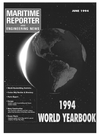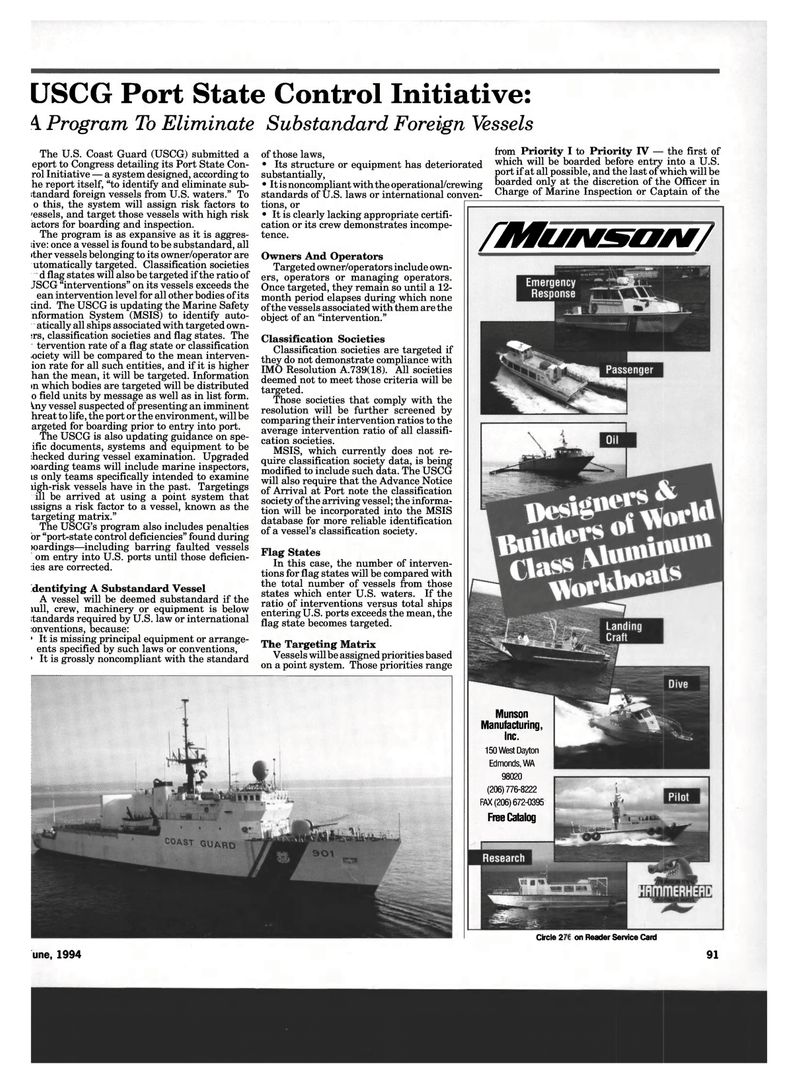
Page 81: of Maritime Reporter Magazine (June 1994)
Read this page in Pdf, Flash or Html5 edition of June 1994 Maritime Reporter Magazine
USCG Port State Control Initiative: 4 Program To Eliminate Substandard Foreign Vessels
The U.S. Coast Guard (USCG) submitted a eport to Congress detailing its Port State Con- rol Initiative — a system designed, according to he report itself, "to identify and eliminate sub- (tandard foreign vessels from U.S. waters." To lo this, the system will assign risk factors to 'essels, and target those vessels with high risk actors for boarding and inspection.
The program is as expansive as it is aggres- iive: once a vessel is found to be substandard, all ither vessels belonging to its owner/operator are lutomatically targeted. Classification societies md flag states will also be targeted if the ratio of
JSCG "interventions" on its vessels exceeds the nean intervention level for all other bodies of its rind. The USCG is updating the Marine Safety nformation System (MSIS) to identify auto- natically all ships associated with targeted own- :rs, classification societies and flag states. The ntervention rate of a flag state or classification .ociety will be compared to the mean interven- ion rate for all such entities, and if it is higher han the mean, it will be targeted. Information >n which bodies are targeted will be distributed o field units by message as well as in list form, ^ny vessel suspected of presenting an imminent hreat to life, the port or the environment, will be argeted for boarding prior to entry into port.
The USCG is also updating guidance on spe- ific documents, systems and equipment to be :hecked during vessel examination. Upgraded warding teams will include marine inspectors, is only teams specifically intended to examine ligh-risk vessels have in the past. Targetings vill be arrived at using a point system that issigns a risk factor to a vessel, known as the targeting matrix."
The USCG's program also includes penalties or "port-state control deficiencies" found during >oardings—including barring faulted vessels rom entry into U.S. ports until those deficien- ies are corrected. identifying A Substandard Vessel
A vessel will be deemed substandard if the lull, crew, machinery or equipment is below standards required by U.S. law or international onventions, because: ' It is missing principal equipment or arrange- nents specified by such laws or conventions, ' It is grossly noncompliant with the standard of those laws, • Its structure or equipment has deteriorated substantially, • It is noncompliant with the operational/crewing standards of U.S. laws or international conven- from Priority I to Priority rV — the first of which will be boarded before entry into a U.S. port if at all possible, and the last of which will be boarded only at the discretion of the Officer in
Charge of Marine Inspection or Captain of the tions, or • It is clearly lacking appropriate certifi- cation or its crew demonstrates incompe- tence.
Owners And Operators
Targeted owner/operators include own- ers, operators or managing operators.
Once targeted, they remain so until a 12- month period elapses during which none of the vessels associated with them are the object of an "intervention."
Classification Societies
Classification societies are targeted if they do not demonstrate compliance with
IMO Resolution A. 739(18). All societies deemed not to meet those criteria will be targeted.
Those societies that comply with the resolution will be further screened by comparing their intervention ratios to the average intervention ratio of all classifi- cation societies.
MSIS, which currently does not re- quire classification society data, is being modified to include such data. The USCG will also require that the Advance Notice of Arrival at Port note the classification society of the arriving vessel; the informa- tion will be incorporated into the MSIS database for more reliable identification of a vessel's classification society.
Flag States
In this case, the number of interven- tions for flag states will be compared with the total number of vessels from those states which enter U.S. waters. If the ratio of interventions versus total ships entering U.S. ports exceeds the mean, the flag state becomes targeted.
The Targeting Matrix
Vessels will be assigned priorities based on a point system. Those priorities range fMujy^mvJ
Circle 332 on Reader Service Card
Munson
Manufacturing,
Inc. 150 West Dayton
Edmonds, WA 98020 (206)776-8222
FAX (206) 672-0395
Free Catalog
June, 1994 91

 80
80

 82
82
